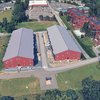Army Corps says no danger
Mother asks if playing fields are safe
GUILDERLAND Christina Diamente is concerned about the safety of the playing fields at Guilderland High School.
She says of student athletes, “They are literally eating the dirt.”
“I don’t know how I send my daughter out to the track team every day…It’s scary,” she told the school board on Tuesday night.
Diamente was joined at the microphone by Maia Boswell-Penc, her teacher for a graduate course at the University at Albany where she became interested in the issue as a class project.
The school property borders the Northeastern Industrial Park, which was once the site of an Army depot. The depot was set up in 1941 as a storage center for the military during World War II. The Army diverted the Black Creek into two halves and sent waste into the creek or buried it on site. The Black Creek feeds the Watervliet Reservoir, Guilderland’s major source of drinking water.
Some of the debris left by the Army is hazardous. When the school district built a bus facility near the high school in 2002, the construction work unearthed some debris. The Army Corps of Engineers paid about half a million dollars to clean it up. The district had purchased, for one dollar, about seven acres from the industrial park for the bus-facility project.
When analyzing work to be done, the Army classifies sites that it considers a risk to human health as areas of concern the local depot has nine.
One of them, designated as Area Of Concern 3, is a burn pit close to the high school property. An underground plume of contaminants from this site was found to be polluting groundwater.
The Army Corps of Engineers began cleanup of the burn pit area in 2003.
Gregory Goepfert, project manager for the Army Corps of Engineers, told The Enterprise yesterday that AOC 3 is being monitored by wells on its perimeter. One of the wells, number 9, which is on the high school property, has a level of volatile organic compounds that is slightly above the standards for drinking water. The trichloroethanol measures at 5.4 parts per billion; the level acceptable for drinking is 5.0.
“Nobody is using that water for drinking,” said Goepfert.
The school gets its drinking water from Guilderland’s municipal system. The athletic fields, however, are watered from a school well nearby.
When asked if athletes could be harmed on playing fields watered by a well with that level of VOCs, Goepfert said, “Even if someone sprayed water from [well] number nine, I don’t think you’d have a hazard. It would volatilize; it would break down in the air.”
That well, he said, will be monitored again this June and again in June 2011.
Diamente has sent each of the school board members and the district administrators a set of four questions she would like answered. She wants to know if the district has tested the soil and the water used on the athletic fields. She also wants to know if the district has asked the Army to remove an underground toxic plume, and if the Watervliet Reservoir has been tested for toxicity.
John McGuire, who has been Guilderland’s superintendent for nearly three years, told Diamente that, before she raised her concerns, he had not been aware of any problems. Safety, he said, is the district’s first priority.
Neil Sanders, the district’s assistant superintendent for business, who joined the district in 2003, told The Enterprise yesterday, “This is the first and only complaint I’ve heard.”
He said that cleanup from the depot is overseen by the state and county health departments as well as the state’s Department of Environmental Conservation and the federal government.
He went on, “We decided we’d like to have an independent, objective view in terms of the cleanup.” So the district has engaged a consultant to study the matter. Sanders declined to name the consultant until the report is complete, at which time he said that it would be made public.
He also said that he had talked with officials at the DEC and the Army Corps. “We’ve been told we don’t have any health hazards,” he said.
Goepfert said yesterday, “Funding under the FUDS program is always a challenge.” The Federal Used Defense Site program gets funded annually. The district that includes the local depot gets $4 million to $5 million a year for over $500 million worth of backlogged cleanup work, he said.
Diamente told the school board that Goepfert had said the way to get money was to have people demand the tests on water and soil.
“We’re not interested in serving people just because they’re stirred up,” said Goepfert yesterday. “We are interested in serving those who are being adversely impacted. We want to protect human health and the environment.”
He went on, “We work closely with the DEC and the DOH…If one of those regulatory agencies thought for one minute there was something of concern, I’m sure they would have brought that to the Corps’ attention.”
Asked about health concerns from drinking water from the Watervliet Reservoir, Goepfert said, “We issued a report on the health issues and found none from the Black Creek.”
History
The Enterprise has written dozens of stories on the nine areas of concern at the Army depot site. In the early part of this decade, the corps concluded that a plume from the burn-pit area containing contaminants above standards set by the DEC appeared to be moving towards the high-school property.
The burn-pit area begins less than 800 feet from the back of the high school on the northern portion of the former depot.
Originally, the burn-pit area was believed to be about a half-acre, but that jumped to about 5.8 acres in 1999 when Quantum Geophysics, Inc. performed a geophysical evaluation of the site. Quantum identified 11 likely disposal areas, according to a Corps commissioned report by Parsons Engineering Science, Inc.
Aerial photographs indicate the area had several dumps and burn pits, beginning in the 1940s, the report states. While interviews with former employees did not reveal the substances buried or burned during the 1950s, patrols were assigned twice daily to check the pit because it sometimes began to burn spontaneously.
The worst of the obvious soil contamination at the burn pit recorded during a field test, was found at a test site about 500 feet from the fence separating the industrial park from Guilderland High School property.
Soils in that area, at a depth of 14 feet, were found to be far in excess of criteria set by the DEC for seven types of carcinogenic materials and heavy metals such as aluminum, lead, and iron.
PCBs above the state standard were also found. PCBs are poly-chlorinated biphenyls, an industrial compound that accumulates in animal tissue with pathogenic effects.
In several samples, dioxins were found at between two and three inches below the surface. In addition to byproducts of manufacturing, dioxins are caused by burning plastics. The worst contamination was at a test site about 300 feet from the school property line.
Water sampled from monitoring wells showed that some contaminants were above state standards. The Army Corps of Engineers concluded that a plume containing these contaminants appeared to be moving in a north-northwesterly direction.
The burn-pit cleanup finally was underway in 2003. It had been postponed when debris was discovered at the bus facility site and the funds were first used there.
Three types of debris were initially unearthed in August 2002 glass vials containing chlorine used by soldiers to purify water; bottles with orthotolidine tablets to test the safety of water; and tubes with anti-lewisite, which soldiers rubbed in their eyes to prevent blistering.
In September of that year, more was unearthed, including bottles with syringes containing water and citric acid used for intravenous regeneration of blood plasma; skin ointment tubes with packaging materials that contained lead; and at least one can of an oily-type of substance.
Nearly three million pounds of soil were removed from the site, dispersed to landfills designed for various kinds of wastes one was in Michigan; another in Pennsylvania.
Ground-penetrating radar was used to see if there were other kinds of debris in the ball field area at the south end of the school property; nothing was found.


